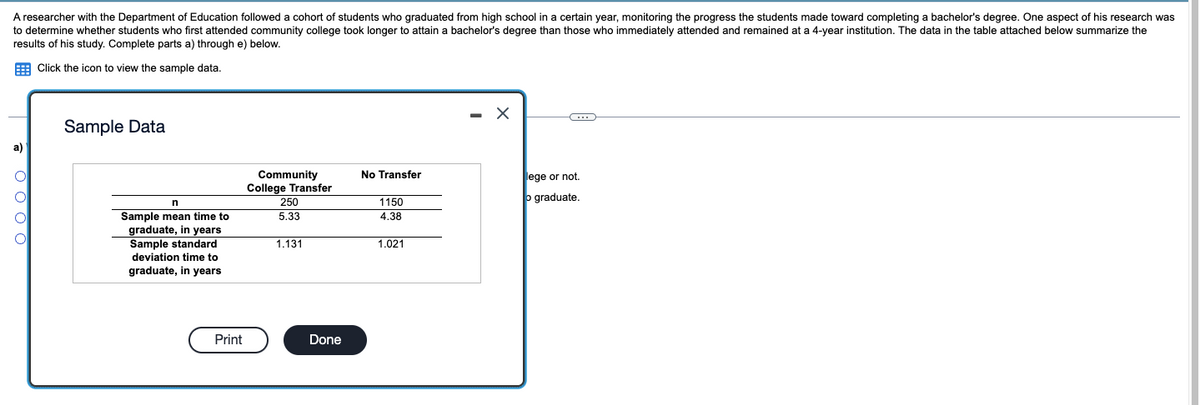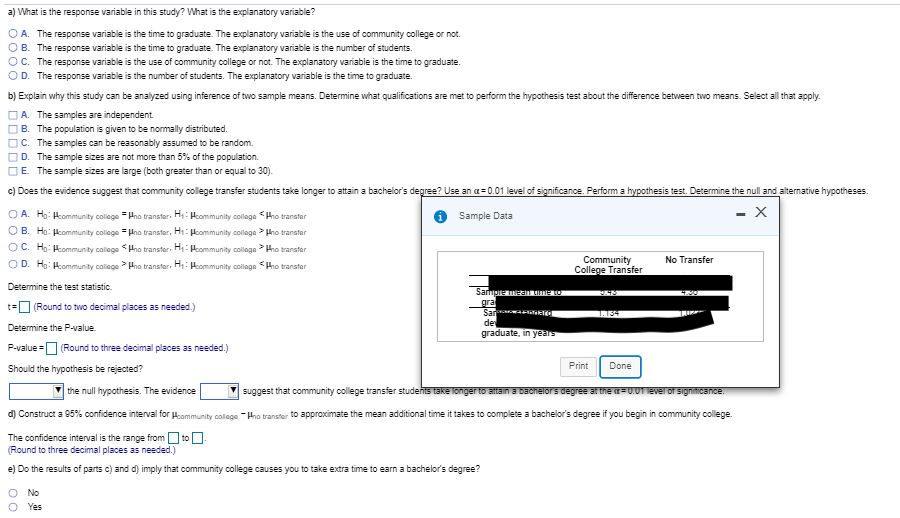A researcher with the Department of Education followed a cohort of students who graduated from high school in a certain year, monitoring the progress the students made toward completing a bachelor's degree. One aspect of his research wa to determine whether students who first attended community college took longer to attain a bachelor's degree than those who immediately attended and remained at a 4-year institution. The data in the table attached below summarize the results of his study. Complete parts a) through e) below. E Click the icon view the sample data. - X Sample Data a) No Transfer Community College Transfer 250 lege or not. o graduate. 1150 Sample mean time to graduate, in years Sample standard deviation time to graduate, in years 5.33 4.38 1.131 1.021
A researcher with the Department of Education followed a cohort of students who graduated from high school in a certain year, monitoring the progress the students made toward completing a bachelor's degree. One aspect of his research wa to determine whether students who first attended community college took longer to attain a bachelor's degree than those who immediately attended and remained at a 4-year institution. The data in the table attached below summarize the results of his study. Complete parts a) through e) below. E Click the icon view the sample data. - X Sample Data a) No Transfer Community College Transfer 250 lege or not. o graduate. 1150 Sample mean time to graduate, in years Sample standard deviation time to graduate, in years 5.33 4.38 1.131 1.021
Linear Algebra: A Modern Introduction
4th Edition
ISBN:9781285463247
Author:David Poole
Publisher:David Poole
Chapter7: Distance And Approximation
Section7.3: Least Squares Approximation
Problem 31EQ
Related questions
Question

Transcribed Image Text:A researcher with the Department of Education followed a cohort of students who graduated from high school in a certain year, monitoring the progress the students made toward completing a bachelor's degree. One aspect of his research was
to determine whether students who first attended community college took longer to attain a bachelor's degree than those who immediately attended and remained at a 4-year institution. The data i
the table attached below summarize the
results of his study. Complete parts a) through e) below.
E Click the icon to view the sample data.
Sample Data
a)
Community
College Transfer
No Transfer
lege or not.
o graduate.
250
1150
Sample mean time to
graduate, in years
Sample standard
5.33
4.38
1.131
1.021
deviation time to
graduate, in years
Print
Done

Transcribed Image Text:a) What is the response variable in this study? What is the explanatory variable?
O A. The response variable is the time to graduate. The explanatory variable is the use of community college or not.
B. The response variable is the time to graduate. The explanatory variable is the number of students.
C. The response variable is the use of community college or not. The explanatory variable is the time to graduate.
D. The response variable is the number of students. The explanatory variable is the time to graduate.
b) Explain why this study can be analyzed using inference of two sample means. Determine what qualifications are met to perform the hypothesis test about the difference between two means. Select all that apply.
A. The samples are independent
B. The population is given to be normally distributed.
C. The samples can be reasonably assumed to be random.
D. The sample sizes are not more than 5% of the population.
E. The sample sizes are large (both greater than or equal to 30).
c) Does the evidence suggest that community college transfer students take longer to attain a bachelor's degree? Use an a = 0.01 level of significance. Perform a hypothesis test. Determine the null and alternative hypotheses.
- X
O A. Ho: Hkommunity colege = Hno transter. H: Hommunity collage Hho transter
O B. Ho: Hcommunity college = Hno transter, Hi: Hcommunity collage > Hho transter
Sample Data
O C. Ho: Hcommunity callege <Hnao transter. Hi: Heommunity colloge > Hho transter
Community
College Transfer
No Transfer
O D. H: Hommunity colilege Hna transfer. H: Hommunity collage <Hho transter
Determine the test statistic.
Sampre meai O
gra
Sar
t=O (Round to two decimal places as needed.)
1.134
de
graduate, in years
Determine the P-value.
P-value = (Round to three decimal places as needed.)
Print
Done
Should the hypothesis be rejected?
the null hypothesis. The evidence
suggest that community college transfer students take longer to attain a bacnelors degree at the=U.01 Ever of signiticance.
d) Construct a 95% confidence interval for Hommunity colage -Hho transter to approximate the mean additional time it takes to complete a bachelor's degree if you begin in community college.
The confidence interval is the range from to -
(Round to three decimal places as needed.)
e) Do the results of parts c) and d) imply that community college causes you to take extra time to earn a bachelor's degree?
No
Yes
ODD
Expert Solution
This question has been solved!
Explore an expertly crafted, step-by-step solution for a thorough understanding of key concepts.
This is a popular solution!
Trending now
This is a popular solution!
Step by step
Solved in 5 steps with 3 images

Recommended textbooks for you

Linear Algebra: A Modern Introduction
Algebra
ISBN:
9781285463247
Author:
David Poole
Publisher:
Cengage Learning

Functions and Change: A Modeling Approach to Coll…
Algebra
ISBN:
9781337111348
Author:
Bruce Crauder, Benny Evans, Alan Noell
Publisher:
Cengage Learning

Glencoe Algebra 1, Student Edition, 9780079039897…
Algebra
ISBN:
9780079039897
Author:
Carter
Publisher:
McGraw Hill

Linear Algebra: A Modern Introduction
Algebra
ISBN:
9781285463247
Author:
David Poole
Publisher:
Cengage Learning

Functions and Change: A Modeling Approach to Coll…
Algebra
ISBN:
9781337111348
Author:
Bruce Crauder, Benny Evans, Alan Noell
Publisher:
Cengage Learning

Glencoe Algebra 1, Student Edition, 9780079039897…
Algebra
ISBN:
9780079039897
Author:
Carter
Publisher:
McGraw Hill

Big Ideas Math A Bridge To Success Algebra 1: Stu…
Algebra
ISBN:
9781680331141
Author:
HOUGHTON MIFFLIN HARCOURT
Publisher:
Houghton Mifflin Harcourt